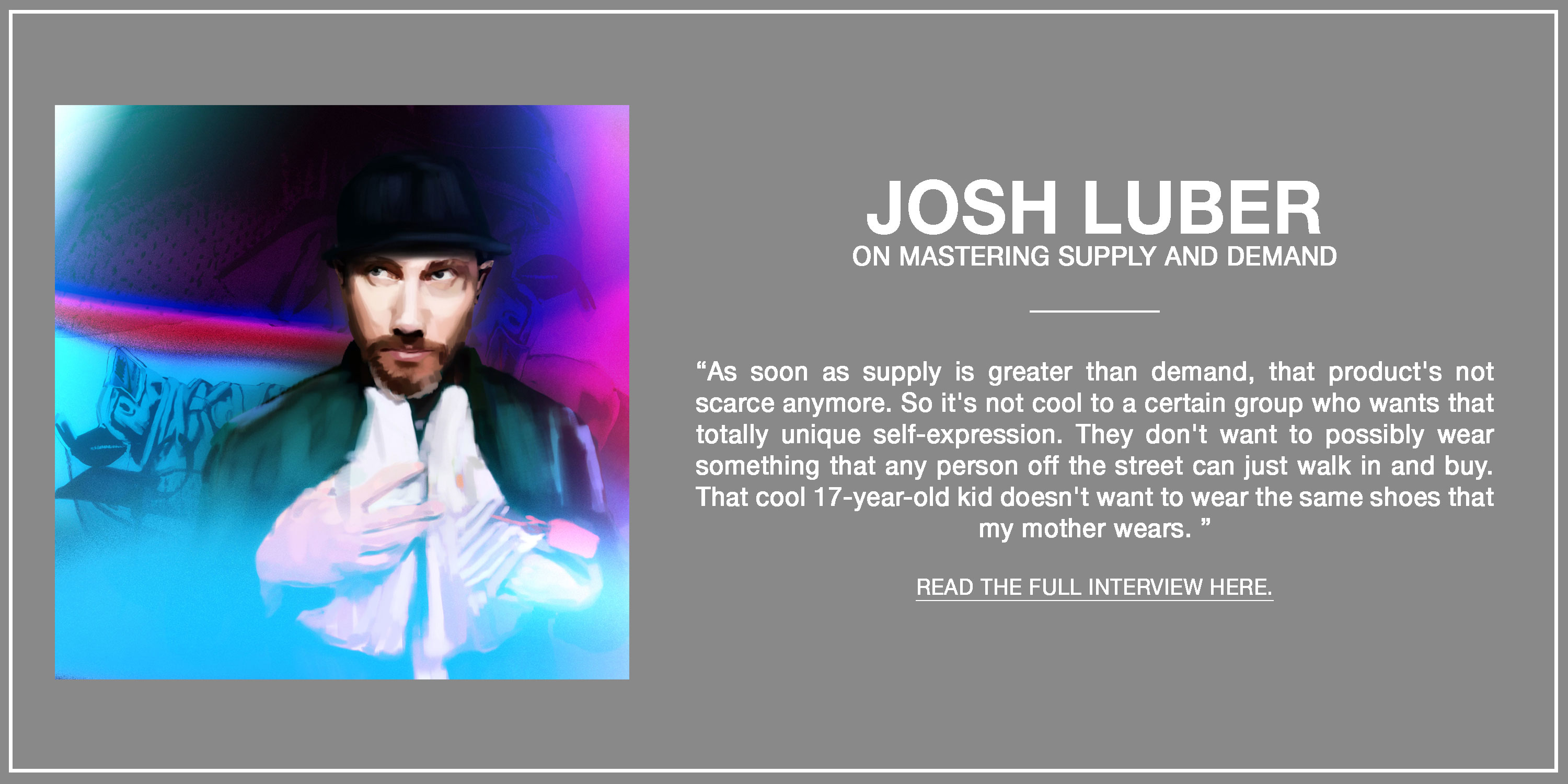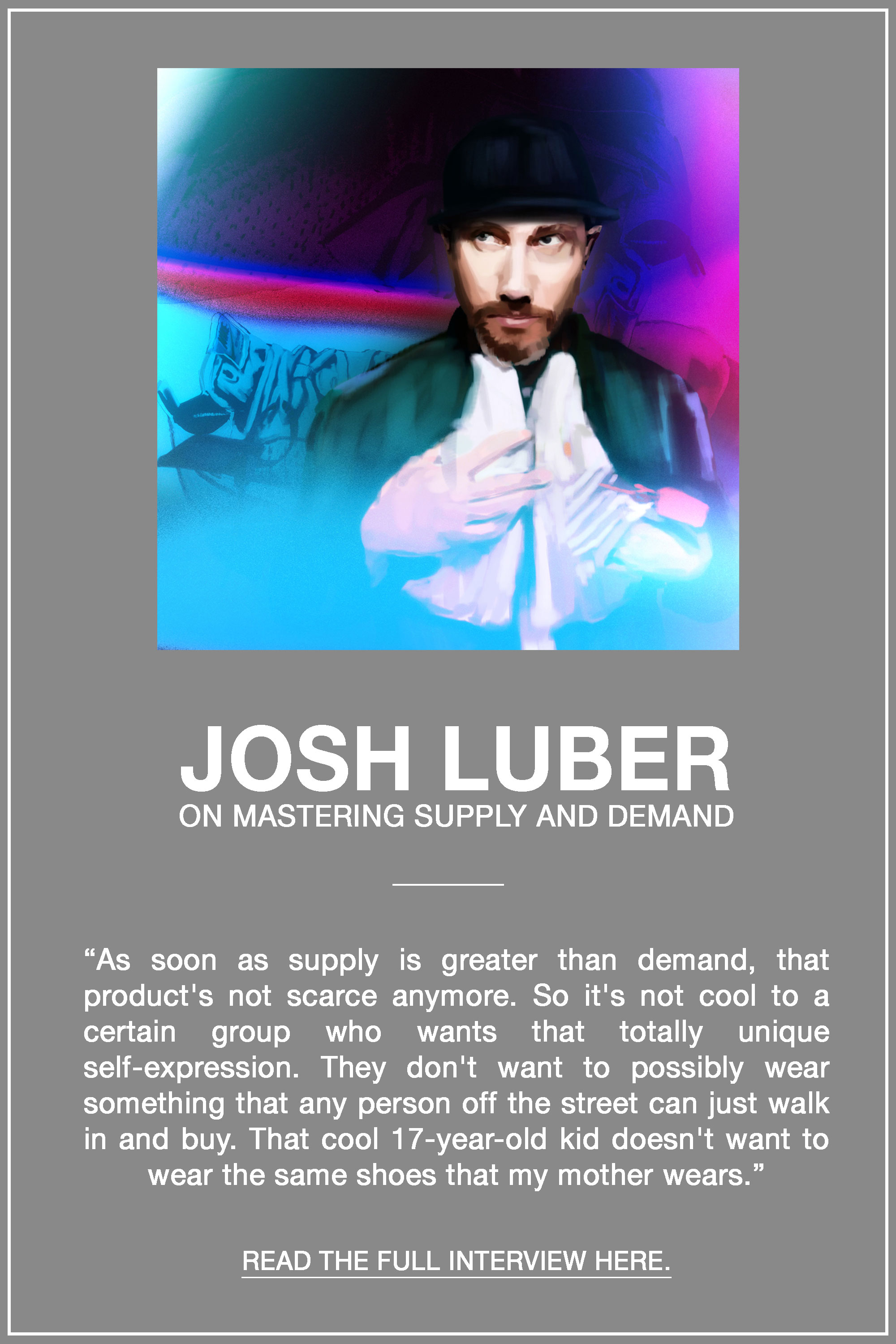Streetwear Impact Report - 004
How Streetwear Sells
This article is part of the Streetwear Impact Report . The report includes data collected through two main research methods: our consumer survey and industry survey. Full description of methodology can be found in the Introduction.
The report is split into four articles. 001 Defining Streetwear details streetwear’s origin and key cultural components. 002 Measuring Streetwear reports consumer spending habits and preferences. 003 How Streetwear Talks traces the communication loop between consumer and brand. 004 How Streetwear Sells dissects streetwear’s tight-knit direct-to-consumer relationship and retail model. Visit the Executive Summary for a full overview.
A true direct-to-consumer relationship
Streetwear companies often build their brand awareness by interacting directly with customers, communicating on social media and meeting consumers in-store. This relationship flies in the face of traditional fashion brands that rely purely on creative directors to provide a vision for each season. Each streetwear brand’s value is derived from a range of sources, including celebrity followers and desirable items, but arguably no factor supersedes authenticity, garnered by relating directly to the customers buying the products and building a tight-knit relationship with the community.
The streetwear consumer trusts the source of creation and harnesses tools like social media to develop a high level of discernment. When there is no cultural cache beyond mere status symbol, the brand and its goods lack resonance. Streetwear consumers expect a personal connection with the brands they purchase and few practices foster this better than an earned direct-to-consumer (D2C) relationship.
When asked through which channels they’re most likely to buy streetwear products, more than half (53%) of consumer respondents indicated a physical brand store, followed by close to half (42%) who indicated a brand’s e-commerce site. About a third of respondents indicated resell sites (28%) and physical multi-brand retailers (32%) while a quarter (26%) reported multi-brand e-commerce and only 13% said social media.
Both digital and physical multi-brand retailers carry less weight than direct brand stores. Many streetwear brands exclusively sell their product, meaning other retailers — with the exception of secondhand platforms — carry little importance in snapping up the latest release.
Comparatively, Asian respondents reported buying more frequently from multi-brand outlets than North American and European respondents. In new streetwear markets where certain niche brands may not have an on-the-ground presence, followers turn to multi-brand stores to purchase.
Our consumer survey findings revealed that social media also carries little weight as a marketplace across regions. Though Instagram has supplanted older online platforms as a means of communication and inspiration, consumers haven’t adopted it to buy and sell products. Similar to multi-brand retailers, the most exclusive products are not currently available for purchase on Instagram. However, Instagram only rolled out new click-through purchase options in March 2019. If streetwear brands with devout followers turn to Instagram to exclusively release their product, the platform could become a leading player for buying and selling streetwear.
Streetwear shoppers reported high and diverse standards for their shopping experiences, placing heavy importance on most aspects of the physical and digital retail experience. However, consumers indicated diversity of product and availability of produced are the most important factors for shopping both online and in-store.
Flagship stores offer brands the chance to meet these high consumer demands, and the industry is savvy to this opportunity, with more than half (60%) of industry respondents reporting flagship locations as an important part of brand strategy and another quarter (25%) reporting flagship stores as somewhere important.
Having a flagship store is key for brands in order to connect with customers, with a physical presence allowing passersby to see, touch and interact with the brand. And though selling products through outside retailers creates more opportunities for consumers to buy the brand, it may undermine the label’s exclusivity. Dover Street Market (DSM) challenges that notion. The boutique carries streetwear brands Supreme, Palace and NOAH, making it the only place to find those labels outside each brand’s flagship store. Notably, DSM rarely sells those brands – or any – online, emphasizing the need for customers to visit the store in person.
By engaging the shopper with frequent and limited releases, retailers can lure in consumers time and time again, even if the digital user experience or store atmosphere are lacking. Streetwear brands operate on a variety of financial levels and the cost of creating a desirable space may weigh heavily on a younger label. Compare the simplicity of Brotherhood’s LA outpost against Carhartt WIP’s Faye Toogood-designed King’s Cross store. Streetwear customers respond as much to effortless, simple design as they do to lavish creations, so long as desire outweighs inconvenience. The clunkiness of Supreme’s website hasn’t slowed down the brand’s hype.
Streetwear brands have proven the viability of a completely digital model, with brands like Anti Social Social Club, Cactus Plant Flea Market and Brain Dead exclusively selling their wares online and through select stockists. However, driving shoppers to the web page in time for a drop remains crucial. This underlines the immensely powerful role of Instagram as a medium of communication, because the platform is almost singularly responsible for giving consumers notice about new merchandise and forthcoming drops.
Brands that sell their products directly to customers cut out the middleman, upsetting the traditional flow of retail by giving fans the opportunity to buy directly from favored imprints. Streetwear’s anti-establishment mentality lends itself well to dominate this independent mindset.
When a product is sold through a community-centric skate shop, for instance, it creates bonds between shoppers, staff, customers and owners. Community, or the perceived application of it, is a cornerstone of the streetwear experience, and forced attempts at entering the market often come under scrutiny.
The “drops model”: streetwear’s strategy
The key tool powering streetwear’s direct-to-consumer relationship is the “drop” model. Brands today adopt two main methods to sell merchandise: launching a complete collection at once or “piecing out” product in a steady stream of consistent releases. Though the former method was the norm for years, Supreme’s adoption of the latter model, known as “drops,” pioneered a new way for brands and retailers to offer product.
The New York streetwear icon was quick to branch out into Japan in the mid-1990s, where founder James Jebbia observed how Japanese stores pieced out seasonal collections. Jebbia noted the eagerness of consumers to make frequent returns to each store so as to keep on top of releases and quickly implemented the same technique. Since then, the drops model has become a key component in how streetwear functions.
With drops, customers are encouraged to be the first in line, the first in store or the first online to secure products, with limited quantities making it likely that pieces will sell out. The promise of new goods is a powerful lure for young shoppers, especially when bolstered by experiential events.
More than half (54%) of consumer survey respondents reported they’re willing to wait in line for a product drop. Another 23% reported they are at least somewhat willing, highlighting the consumer’s eagerness for streetwear items. Having been taught that drops are only offered in limited supply, shoppers are trained to view every sneaker drop and product release as a once-in-a-lifetime moment. Limited, if any, restocks further underline the time-sensitive nature of the model.
Supreme’s immense influence has inspired widespread adoption of this model, with a surprisingly broad array of companies adopting the technique. Not only do skate and street brands engage in drops, but larger fashion houses have also elected to make specific deliveries of goods to customers or boutiques in limited numbers.
Kim Jones’s Spring/Summer 2019 Dior collection, marked by its collaboration with leading contemporary artist KAWS, adopted this model with a series of pop-up drops rolled out across the globe. Perhaps the most dramatic example of a luxury house using the drops method is Burberry. Under the direction of Riccardo Tisci, the historic British brand has divided its offering into various sub-lines, which includes the street-friendly B Series distributed through a drops model.
Two-thirds (66%) of industry survey respondents described the drops model as important or very important to their business, across all brand and company types. Unsurprisingly, a large majority (78%) of footwear brands surveyed, including luxury brands and core streetwear companies, indicated the model was important to their strategy. This highlights the industry’s desire to tap into the streetwear frenzy.
For luxury and streetwear brands alike, maintaining limited supply is a crucial component of the drops model because it rewards customers who are willing to put in extra effort for new items and feeds a growing resale market. Now, even semi-hyped sneaker drops are selling out immediately, despite limited returns on the secondhand market.
Resale: streetwear’s barometer
The drops model has resulted in a booming secondhand market. Buyers who miss out on drops will turn to other methods of shopping, while those who successfully purchased items will often look to make a quick buck. The resale market is thus a barometer for a brand’s success.
The streetwear model ultimately operates on a pure equation of supply and demand. If mastered successfully, a brand will leverage “drops” to keep the supply of a new product strictly below demand. In turn, the product will experience high sell-through, appear on the resale market at a higher price, create more desire and raise the value of the brand.
The tipping point between supply and demand is crucial. Once the supply of a product surpasses demand, the entire model crumbles. Plainly, if a product does not immediately sell out and hit the resale market at a premium, a brand has not been successful in implementing the streetwear model.
Though consumers primarily buy streetwear products through first-hand sources (physical retail or e-commerce sites owned by brands), resell sites were the third most-reported platform for purchasing streetwear products. Popular resell sites vary by region. Among North American and European respondents, StockX is reported as the most popular platform, while a higher percentage of Asian respondents reported using Facebook groups.
A majority (70%) of respondents said they bought no more than a quarter of their items through resale, meaning a third of consumers are buying at least a third of their items exclusively through the resale market. While it is almost entirely driven by unofficial channels, the resale market is significant enough that 69% of industry respondents find the resale business model attractive to tap into.
Active resellers made up a minority of consumer survey respondents, with about half (48%) of consumers reporting they didn’t resell anything. Logically, the consumer respondents who reported reselling a higher percentage of their collection also reported, on average, a higher monthly spend on streetwear.
Less active resellers may represent young sellers who have limited resources and leverage the market to make money and purchase their desired goods. More active resellers, meanwhile, may represent small business owners and cottage industries who have created entire businesses out of resale.
Shoppers with higher expendable income, who are not willing to wait in line for a drop or miss out on purchasing a drop online, have sites like StockX and Grailed to turn to. What results is an endless loop of streetwear items passing through different hands. What differentiates streetwear from fashion at large is that there are two ways to enter: waiting in line or paying a premium.



